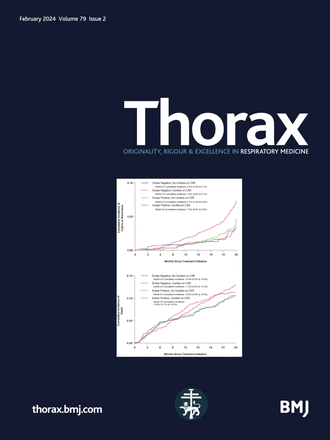Short-term efficacy of inhaled short-acting beta-2-agonists for acute wheeze/asthma symptoms in preschool-aged children: a systematic review and meta-analysis
IF 9
1区 医学
Q1 RESPIRATORY SYSTEM
引用次数: 0
Abstract
Background Inhaled short-acting β2-agonists (SABA) is recognised as an effective treatment in adults and older children with asthma, but the effect in young children and infants is still up for debate. We examine the efficacy of inhaled SABA for preschool-aged children presenting with acute wheeze/asthma in this systematic review and meta-analysis. Methods PubMed and Embase were searched through August 2024. Clinical trials investigating the effect of inhaled SABA on acute wheeze/asthma symptoms in children below age 6 years were included. The study followed Preferred Reporting Items for Systematic Reviews and Meta-Analyses guidelines. Summary standardised mean differences, 95% CIs and p values were derived from random effects meta-analyses to analyse the effect on clinical composite respiratory score, respiratory rate, oxygen saturation, respiratory work and degree of wheezing. Results A total of 19 studies including 1022 children were included. Treatment with inhaled SABA showed decreased respiratory score within 60 min (10 studies, N=523): standardised mean difference −2.05 points (95% CI −2.50; −1.59), I2=86%, p<0.001, decreased respiratory rate (8 studies, N=319): −0.86 (95% CI −1.30; −0.41), I2=87%, p<0.001, increased oxygen saturation (7 studies, N=190): 0.56 (95% CI 0.16; 0.95), I2=71%, p<0.01, decreased respiratory work (3 studies, N=68): −0.80 (95% CI −1.60; −0.00), I2=74%, p=0.05 and decreased wheezing score (3 studies, N=68): −1.07 (95% CI −1.80; −0.33), I2=72%, p<0.01. Subgroup analyses of children below age 2 years showed similar significant effects for all outcomes. Conclusions Inhaled SABA treatment for acute wheeze/asthma symptoms showed beneficial effects in young children and infants. Findings from this study may provide evidence to support inhaled SABA in future treatment guidelines for acute wheeze/asthma among young children and infants; however, an overall high heterogeneity and small sample size of the studies were a limitation. PROSPERO registration number CRD42023429381. No data are available.吸入短效β -2激动剂治疗学龄前儿童急性喘息/哮喘症状的短期疗效:一项系统综述和荟萃分析
吸入短效β2激动剂(SABA)被认为是治疗成人和年龄较大的儿童哮喘的有效方法,但对幼儿和婴儿的效果仍存在争议。在这项系统综述和荟萃分析中,我们研究了吸入SABA对急性喘息/哮喘学龄前儿童的疗效。方法到2024年8月检索PubMed和Embase数据库。纳入了研究吸入SABA对6岁以下儿童急性喘息/哮喘症状影响的临床试验。该研究遵循了系统评价和荟萃分析指南的首选报告项目。随机效应荟萃分析得出总标准化平均差、95% ci和p值,分析临床复合呼吸评分、呼吸频率、氧饱和度、呼吸功和喘息程度的影响。结果共纳入19项研究,1022名儿童。吸入SABA治疗在60分钟内显示呼吸评分下降(10项研究,N=523):标准化平均差- 2.05分(95% CI - 2.50;−1.59),I2=86%, p<0.001,呼吸速率降低(8项研究,N=319):−0.86 (95% CI−1.30;−0.41),I2=87%, p<0.001,血氧饱和度升高(7项研究,N=190): 0.56 (95% CI 0.16;0.95), I2=71%, p<0.01,呼吸功减少(3项研究,N=68): - 0.80 (95% CI - 1.60;- 0.00), I2=74%, p=0.05,喘息评分降低(3项研究,N=68): - 1.07 (95% CI - 1.80;−0.33),I2=72%, p<0.01。2岁以下儿童的亚组分析显示,所有结果都有相似的显著影响。结论吸入SABA治疗婴幼儿急性喘息/哮喘症状效果显著。本研究的发现可能为未来儿童和婴儿急性喘息/哮喘的治疗指南中支持吸入SABA提供证据;然而,研究总体上的高异质性和小样本量是一个局限性。普洛斯彼罗注册号CRD42023429381。无数据。
本文章由计算机程序翻译,如有差异,请以英文原文为准。
求助全文
约1分钟内获得全文
求助全文
来源期刊

Thorax
医学-呼吸系统
CiteScore
16.10
自引率
2.00%
发文量
197
审稿时长
1 months
期刊介绍:
Thorax stands as one of the premier respiratory medicine journals globally, featuring clinical and experimental research articles spanning respiratory medicine, pediatrics, immunology, pharmacology, pathology, and surgery. The journal's mission is to publish noteworthy advancements in scientific understanding that are poised to influence clinical practice significantly. This encompasses articles delving into basic and translational mechanisms applicable to clinical material, covering areas such as cell and molecular biology, genetics, epidemiology, and immunology.
 求助内容:
求助内容: 应助结果提醒方式:
应助结果提醒方式:


